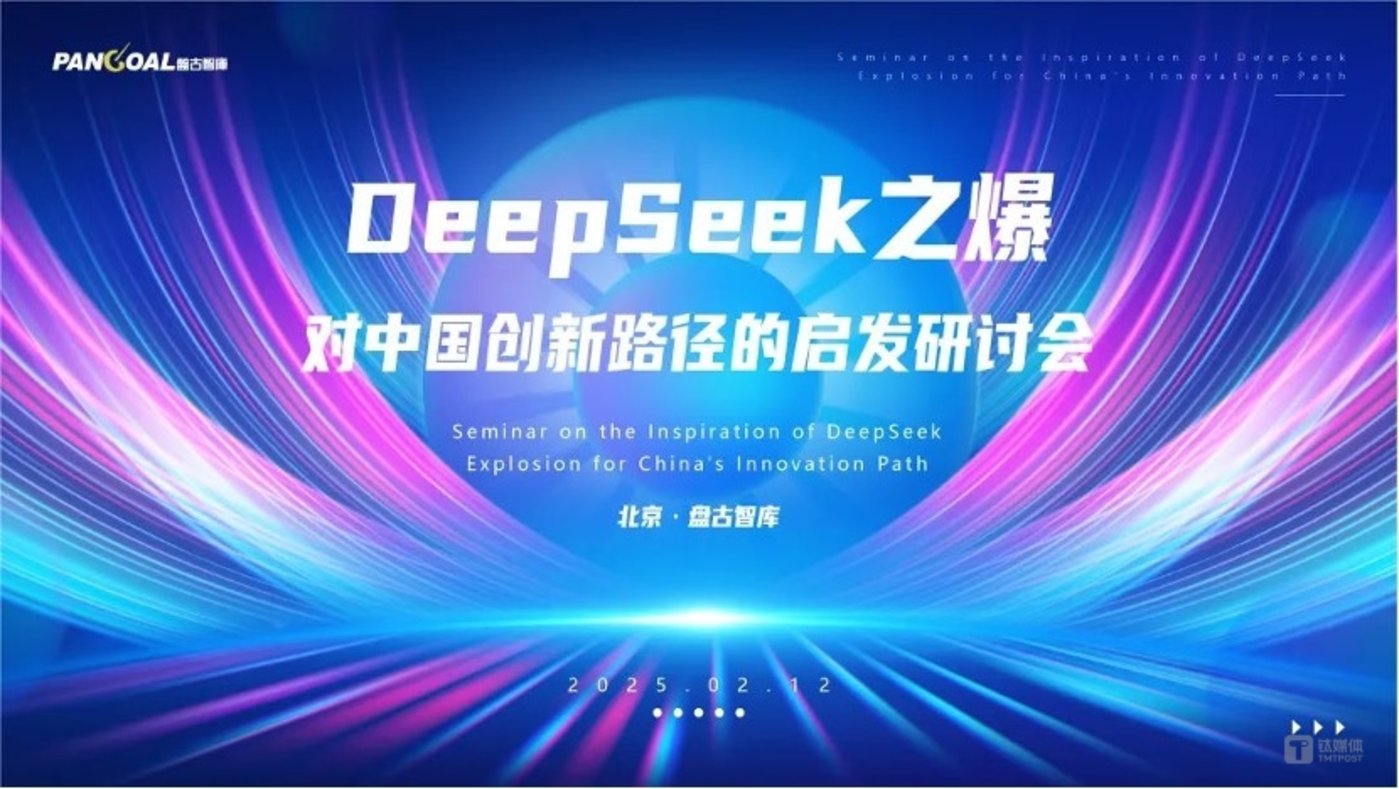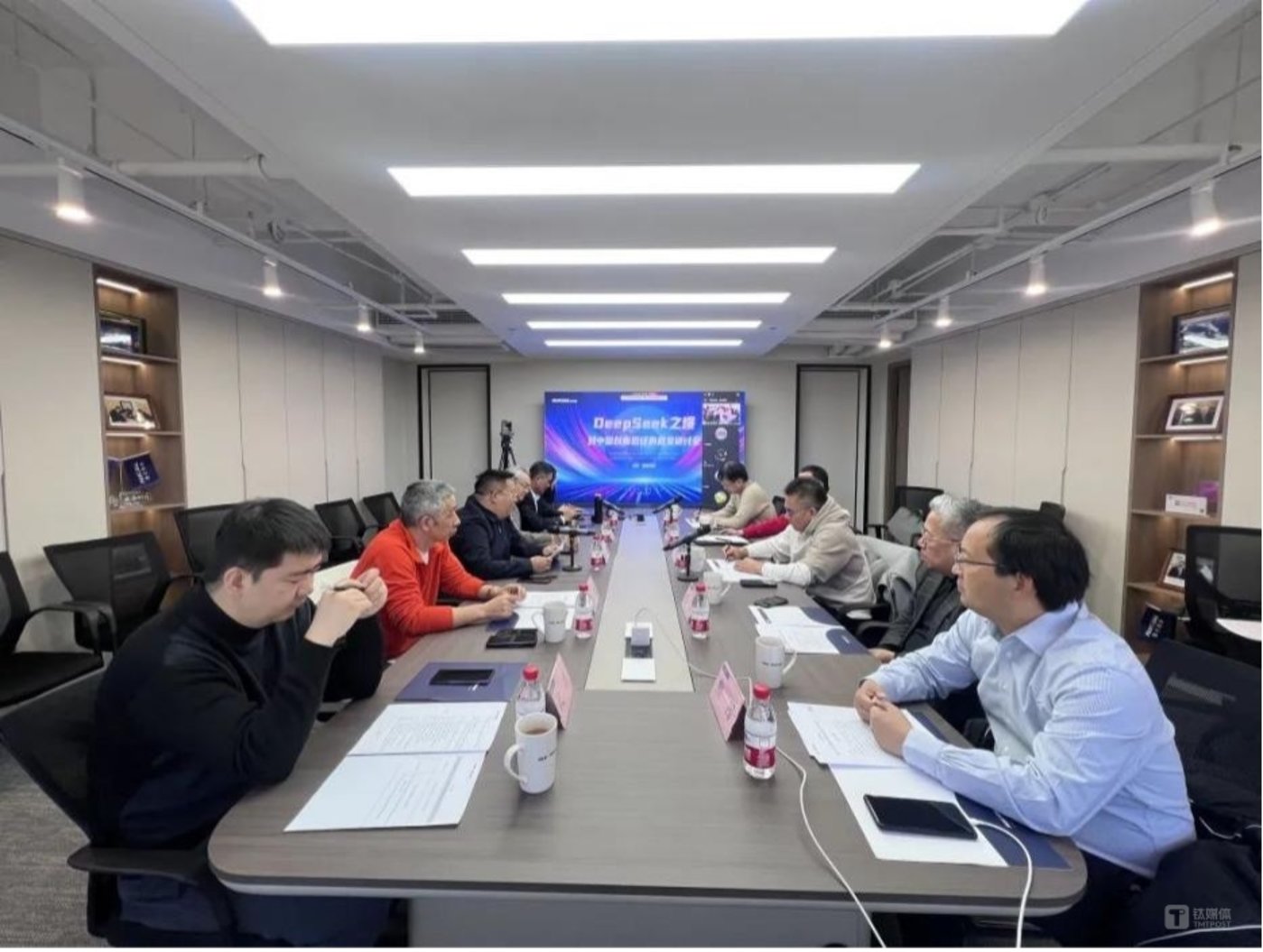During the just-past Spring Festival of the Year of the Snake, China AI start-ups explored DeepSeek and “Nezha’s Devil Boy Causing the Sea”(referred to as “Nezha 2”) in depth, and made strong achievements at the intersection of technology and culture respectively. “Nezha 2” exceeded 10 billion yuan in box office and became a phenomenal work. At the same time, relying on its performance advantages and open source strategy, the DeepSeek R1 model has become the fastest AI application to exceed 30 million daily users, bringing the public’s attention to technological innovation to an unprecedented level.
On February 12, Pangu think tank held a seminar on the inspiration of the DeepSeek explosion on China’s innovation path, with more than 100 guests attending the seminar online and offline. Yi Peng, chairman of the Pangu Think Tank, presided over the meeting and delivered an opening speech. In the context of the current Sino-US game and the new era of navigation, DeepSeek has brought us a lot of inspiration on what China should do for innovation. DeepSeek and “Nezha 2” are a touch on China’s innovative systems and mechanisms and all aspects. We must re-examine the power of the market, the power of funds, the power of scenarios, the power of young people and the power of a relaxed environment.
What do you think of DeepSeek?
What inspiration does DeepSeek’s explosion inspire us?
And how will this phenomenal product affect China’s innovation system and mechanism?
Against the background of the emergence of the AI ecosystem, the three major topics became the core focus of discussions among the guests.
From “Nezha” to DeepSeek, start 2025 with national comic + technology
The popular DeepSeek and “Nezha”, even if they are not considered products of the national Games, are destined to bring huge industry popularity and centripetal force to China, because they tell people that huge energy can explode in many small corners of China
——Xiong Yuan, senior researcher at Pangu Think Tank and chief economist at Guosheng Securities
Benefiting from the natural communication potential formed by Western audiences ‘curiosity about China culture,”Nezha 2″ uses more than 1900 special effects shots and more than 10000 special effects elements in the movie to achieve the goal of reaching the audience frame by frame. The millimeter-level touch also realizes the transformation from a cultural deficit to a surplus. Despite the influence of the Western world’s cognitive filtering of China technology companies in the traditional sense, DeepSeek has still set off an unprecedented craze around the world and is also praised as a new landmark in the world’s third wave of artificial intelligence. event.
Hu Yanping, academic member of Pangu Think Tank and chief expert of DCCI Future Think Tank and FutureLabs Future Laboratory, pointed out that DeepSeek has made a model with low cost that is close to ChatGPT o1 in principle and has made it open source to the world. The three key points of low cost of computing power, o1-like principles, and open source are the reasons for its huge repercussions and the essence of this matter. The highlights of DeepSeek are actually reinforcement learning, mixed expert model MoE, knowledge and model distillation, multi-head attention, multi-token prediction, mixed precision training, PTX, etc. The further the sorting goes, the more technical value to the model level., the higher the ranking goes, the higher the engineering value to cost-efficiency.
The activity of the capital market also confirms the popularity of DeepSeek. Xiong Yuan, a senior researcher at Pangu think tank and chief economist at Guosheng Securities, believes that generally speaking, the theme of market hype in the first week of the Spring Festival is the theme of the whole year. With the emergence of DeepSeek, everyone seems to have felt that 2025 may become the year when AI will be implemented in China.
“I found that for the financial industry, because most of the financial industry is still written by people, whether writing IPOs in investment banks, various annual reports, including speeches written by government agencies, AI now writes much better speeches than you. He said that DeepSeek will definitely change deeply in many industries, including the financial industry, especially many basic, written, and service-oriented jobs.
From “Nezha 2” to DeepSeek, this phenomenon actually reflects the dual trajectory of China’s soft power export: cultural products quickly establish awareness through “emotional shortcuts,” while technology brands need to penetrate “technical trust barriers” to achieve breakthroughs. As China’s technology companies shift from technology follow-up to “paradigm innovation” and upgrade their communication strategies, it is believed that this cognitive gap will gradually narrow. In the future, more technical ambassadors will be needed in more industries to build bridges for cross-cultural understanding.
Liang Wenfeng is another living Nezha who is not a well-known and upright man but has fought his way out.
When entrepreneurship is the road to Huashan, people will definitely get used to finding the path with the least risk and the fastest effect, which is plagiarism. But when entrepreneurship is just an attitude towards life, you must have endless things to think about.
——Xiong Zhihui: Founder and General Manager of Zhiping Times
When it comes to the inspiration DeepSeek brings, confidence has become the ultra-high-frequency word that appears in the discussion. Liu Miao, academic member of Pangu think tank and founder and chairman of Turing New Smart Computing, said that the emergence of DeepSeek has confirmed his confidence in moving towards the final AGI. Due to the improvement of system efficiency and quality, the cost per Token has dropped sharply, which will definitely lead to the outbreak of the smart computing industry, and the Jevons Paradox reappears. DeepSeek has given the entire industry great confidence, whether it is the government, investors, or upstream and downstream chains. At the same time, DeepSeek’s success is a testament to engineering optimization. DeepSeek takes every link to the extreme and achieves high-quality and low-cost results. Its success proves that it is completely feasible to optimize the entire system through an engineering path.
Faced with the blockade of small courtyards and high walls, lack of resources will force innovation. This kind of determination in adversity is equally important. Xing Jie, author of China’s first meta-universe book and chairman of Youshi Capital, compared DeepSeek founder Liang Wenfeng to another living Nezha, who was not a well-known and upright man but fought his way out. In the adversity of only living once, Liang Wenfeng chose All In, which is the path after small-scale verification, and invested all his computing power resources. It was precisely because of the lack of computing power that forced him to do assembly language programming, and lack turned into wealth. Many major manufacturers don’t have this spirit yet, but DeepSeek has done it.
Some people say DeepSeek is not innovative. But conversely, whether it is reinforcement learning or MoE architecture, DeepSeek is innovative in every aspect. Hu Yanping, academic member of Pangu Think Tank and chief expert of DCCI Future Think Tank and FutureLabs Future Laboratory, described the inspiration DeepSeek brought in the definition of innovation. He said that China’s business format is very different from that of the United States, but from a technical perspective, it follows the same trend. The biggest difference between China and the United States may lie in our sustainable development capabilities, sustainable iteration capabilities, especially the ability of the industrial market to form a commercial closed loop. This industrial closed loop is not only for technical products and market users, but also for the capital market.
Wu Sheng, founder of the Scenario Laboratory and creator of the Scenario Methodology, also said that“ drawing on” the methodology of optimization was confirmed as early as the first industrial revolution. When it comes to steam engines, everyone remembers Watt, but Watt is actually not the originator of steam engines. DeepSeek’s accumulated efforts and its emergence allow us to see a complete application developer who reduces costs and increases efficiency in the industry, solves problems and creates value efficiency. It still has a good methodology to work hard to achieve miracles, and the most important thing is to quickly enter this segmented scene and field. Rapidly entering the knowledge base of thousands of industries, only experience can drive the exponential growth we see. It is not a flash in the pan, but a more endless innovation ecosystem.
DeepSeek and “Nezha” are both touches on China’s innovation system and mechanism
DeepSeek is just our peak towards AGI, but it is not the ultimate Himalaya
——Liu Miao: Academic member of Pangu Think Tank, founder and chairman of Turing New Smart Computing
Compared with the traditional top-down mainstream technological innovation constitution, the more market-oriented innovation system verified by DeepSeek is worth thinking about. Qin Shuo, an observer of humanities and finance and founder of Qin Shuo’s circle of friends, said that this DeepSeek incident transcends the general scope of technological innovation. It allows people to see the competitiveness of China’s enterprises and rethink the valuation of national capabilities between China and the United States. More importantly, DeepSeek makes people think about what kind of place China is. What kind of system can innovation occur. If there are truly such innovations in the future in China, further breakthroughs will be needed in institutional arrangements, goals and culture. Only then can we have new achievements in the direction represented by DeepSeek, and our innovation in the entire China will bring us more confidence.
From the perspective of urban development, as the birthplace of DeepSeek and Nezha, Hangzhou and Chengdu have many similarities. Whether it is assistance to small and micro enterprises or flexible governance, it is no accident that DeepSeek and Nezha were born in these two new first-tier cities in China. Liang Chunxiao, deputy chairman of the Academic Committee of Pangu Think Tank and chief expert of the Institute of Aging Society, discussed the new drivers behind China’s innovation path from the urban perspective. Comparing Shenzhen, which is at the forefront of reform and opening up, with Hangzhou, the birthplace of DeepSeek, Zhang Bei, former president of 360 Group and chairman of Qianhai Data Services Co., Ltd., also said that Shenzhen needs to introduce more universities in the future and allocate more investment in science and technology innovation to potential Small and medium-sized enterprises pay more attention to the government’s personalized services, making the city’s innovation soil more fertile.
In the academic field, Xia Chun, chief economist of Shangshan Capital Group, called for the need to give young people more opportunities. After gaining opportunities, many young people have unlimited ideological realms. In fact, there are many young professors and scholars aged 30 and 40. Although their research results may not be known, they are widely recognized internationally, so a more reasonable assessment mechanism is worth exploring. Zhang Zhongxiang, academic member of the Pangu Think Tank and founding dean of the Ma Yinchu School of Economics at Tianjin University, also said that improving the return of basic research for young people, rather than exaggerating performance, will help more young people make innovations that are sidelined, and this is the basis for the future China-style innovation path.
Experts attending the meeting said that the emergence of DeepSeek marks the beginning of the take-off of China’s AI 2.0 industrial market, but whether it can fly depends on what we do for these companies from the perspective of innovation ecology, as well as whether DeepSeek itself and industry companies can complement each other and do something together in the future. In addition, the participating experts also focused on the reform and implementation of cutting-edge fields of education, the key role of financial capital in supporting scientific and technological innovation, the dominant position of enterprises in the innovation ecosystem, the innovative ideas of enterprises, and the importance of cultural atmosphere to innovation. In-depth discussions were conducted on the topics and their respective research results and practical experience were shared.





